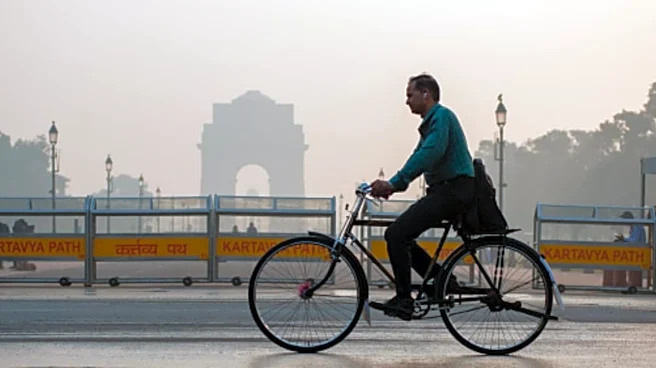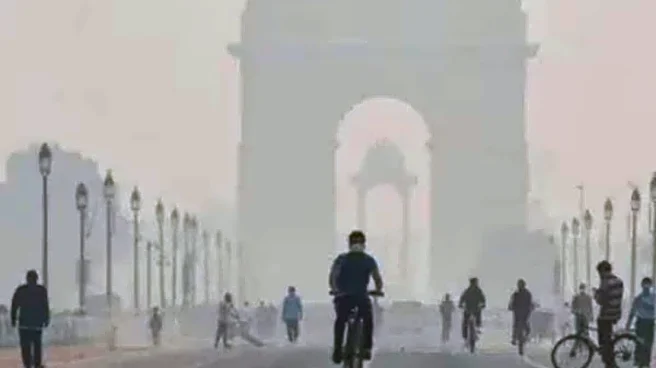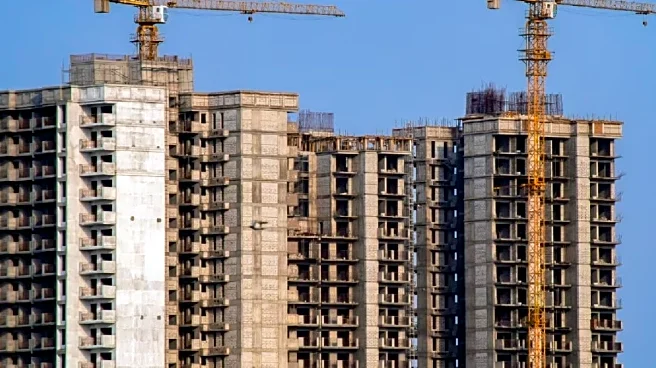Air pollution is no longer just a seasonal or environmental concern; it has begun to shape everyday life, from travel choices to healthcare priorities. On Sunday morning, the Indian national capital continued to struggle with poor air quality. Data from the Central Pollution Control Board (CPCB) recorded the Air Quality Index (AQI) around ITO at 284, categorising it as “poor.”
In India, where rapid urbanisation and industrialisation are accelerating pollution, the economic ripple effects are becoming impossible to ignore. The so-called “smog economy” is emerging, revealing a landscape where air quality is a decisive factor in tourism, real estate, and healthcare spending. Simply put, the air people breathe is now shaping financial behaviour as
much as it is affecting physical health, creating new challenges and opportunities in equal measure.
In cities such as Delhi, Lahore and Beijing, air quality index (AQI) levels do not just determine whether schools remain open, they influence property prices, medical bills, and holiday destinations. What this really means is that polluted air is now affecting financial behaviour as much as physical wellbeing. The air people breathe is sublty influencing economies, reshaping industries, and widening social divides.
According to the World Bank, air pollution cost the global economy approximately 8.1 trillion US dollars in 2019 and around 6.1% of global GDP. The evidence suggests that this is not simply an environmental or health issue; it is an economic one.
How is Air Pollution Changing the Way People Travel?
Travel choices are no longer based solely on cost, convenience, or Instagram appeal. Increasingly, travellers are weighing the cost of poor air quality. A growing number of people are choosing destinations with cleaner air, seeking what many call “air detox holidays.” Resorts in Bhutan, Sikkim, and the Himalayan foothills are marketing themselves on the promise of pure air, while international destinations such as Finland, Iceland, and New Zealand promote air purity as a form of luxury.
Data supports this shift, a study published by MDPI found that air pollution in urban tourist destinations significantly reduces visitor numbers and threatens the economic sustainability of tourism. Similarly, research published by PMC in 2023 demonstrated that the state and variability of air pollution directly influence the intensity of tourism traffic. When AQI levels worsen, tourists cancel or shorten their stays.
Closer to home, the impact is measurable. A 2025 study on Delhi-NCR revealed a positive correlation between improved air quality and foreign tourist arrivals, particularly during the COVID-19 lockdowns when pollution levels dropped dramatically. Conversely, spikes in pollution caused by stubble burning and vehicular emissions led to noticeable declines in tourism. According to AQI.in, India’s tourism industry is losing an estimated 1.7 billion US dollars annually due to shorter tourist stays and reduced arrivals.
Airlines and hospitality brands are responding to this behavioural change. Several high-end resorts are partnering with wellness companies to offer “lung health retreats,” incorporating breathing therapies, forest walks, and pollution-monitoring as part of the experience. Domestic travellers, too, are beginning to filter travel searches by AQI levels rather than by budget or star rating. Clean air is quietly becoming the new currency in global tourism, much like sustainability was a decade ago.
Is Healthcare Paying The Price in the Smog Economy?
Hospitals across India report a consistent rise in chronic respiratory and cardiovascular diseases linked to air pollution. Pulmonology departments are expanding, and preventive healthcare packages now routinely include lung function tests and air pollution risk assessments. The pharmaceutical industry, meanwhile, is seeing unprecedented growth in respiratory aids such as inhalers, purifiers, and supplements.
A study published in 2021, on the impact of air pollution on residents’ medical expenses found that short and medium-term exposure to air pollution can significantly increase medical expenses, while optimised air quality leads to measurable reductions in total healthcare costs.
Globally, the numbers are staggering. The World Economic Forum (2021) reported that air pollution from fossil fuels costs each American approximately 2,500 US dollars per year in medical expenses and contributes to around 107,000 premature deaths annually. The World Bank’s estimate of 8.1 trillion US dollars in annual health-related costs from air pollution underscores the enormity of this issue.
In India, the economic burden is particularly acute. A 2025 study estimated the annual economic loss caused by PM10 pollution at roughly 135.4 billion US dollars equivalent to around four per cent of India’s GDP. This figure includes both direct healthcare costs and lost productivity. In 2025, Indian health insurance providers proposed premium hikes of up to 15 per cent in cities such as Delhi, citing a surge in pollution-related claims.
The healthcare industry’s expansion, though profitable, carries a tragic irony. While the sector grows to accommodate pollution-induced illnesses, the human and financial cost of breathing continues to climb. Air pollution has effectively become a chronic epidemic, one that is creating new economic opportunities while deepening public health vulnerabilities.
Is Real Estate Market Adapting to the Air Quality Crisis Too?
The property market has long reflected shifts in lifestyle preferences, but air pollution is now a defining factor in real estate trends. Developers are incorporating “air quality ratings” into their listings, much like energy efficiency scores. Luxury apartments in Delhi, Mumbai, and Bengaluru are advertised with built-in air filtration systems, rooftop gardens, and anti-smog ventilation.
Tier-2 cities with better AQI such as Dehradun, Coimbatore, and Mysuru are witnessing a rise in demand from professionals seeking cleaner, slower-paced lives while continuing remote work, says Ministry of Housing and Urban Affairs report (2023). In Delhi NCR, the National Green Tribunal has even imposed temporary bans on construction activity when AQI levels exceed 400, causing costly delays and missed deadlines.
This has given rise to a new kind of gated community marketed not for its amenities, but for its promise of breathable air. Air quality has joined proximity and affordability as a key determinant of property value. What this really means is that pollution is influencing not only where people live, but how developers design the urban landscape.
Who Can Afford Clean Air?
Access to clean air has quietly become a marker of privilege. Wealthier urban residents can purchase air purifiers, invest in gated communities, or escape to hill stations when pollution peaks. For the majority, however, air quality remains an uncontrollable variable. This disparity is widening the health and social gap between income groups.
Policy experts argue that pollution is emerging as a new form of inequality. It divides societies not only by wealth, but by the basic right to breathe without harm. For lower-income groups, exposure to polluted air is a daily reality affecting productivity, long-term health, and even educational outcomes. Meanwhile, the affluent can buy insulation from smog in the form of technology and geography.
Governments are responding, but often reactively. Measures such as odd-even traffic schemes, temporary school closures, and bans on construction offer short-term relief but do little to address structural pollution sources. The challenge now is not only to improve air quality but to ensure that access to clean air does not become an exclusive commodity.
Why Smog And Pollution is Impacting Global Economy?
The economic consequences of air pollution extend far beyond healthcare and real estate. They touch every sector, from agriculture to insurance. As pollution reshapes consumer behaviour, companies are being forced to adapt. The rise of pollution-linked products from anti-smog masks to smart air purifiers represents an entirely new market segment, estimated to be worth more than 15 billion US dollars globally by 2026.
Yet, this adaptation cannot replace prevention. Economists warn that unless air quality improves, productivity losses will continue to mount. A 2024 report by the Lancet Planetary Health estimated that air pollution contributes to more than two million premature deaths annually in India alone, driving both economic and human costs.
Investments in renewable energy, stricter emissions policies, and urban green planning are now not only environmental imperatives but economic necessities. The longer pollution persists, the more it erodes the foundation of sustainable growth.
The smog economy is not a futuristic concept. It is already here shaping markets, altering behaviours, and redefining what comfort and health mean in the modern world. Air pollution has evolved from an environmental concern into a full-fledged economic force that influences how people travel, where they live, and how they spend.
The irony is stark because the fight for clean air has become a new kind of privilege economy. From wellness retreats to real estate premiums, pollution has found a way to monetise itself. The global challenge now is not just to survive the smog, but to ensure that clean air remains a right not a luxury.


/images/ppid_a911dc6a-image-176078438156664855.webp)
/images/ppid_a911dc6a-image-176064022898230139.webp)
/images/ppid_59c68470-image-176061753184774794.webp)










